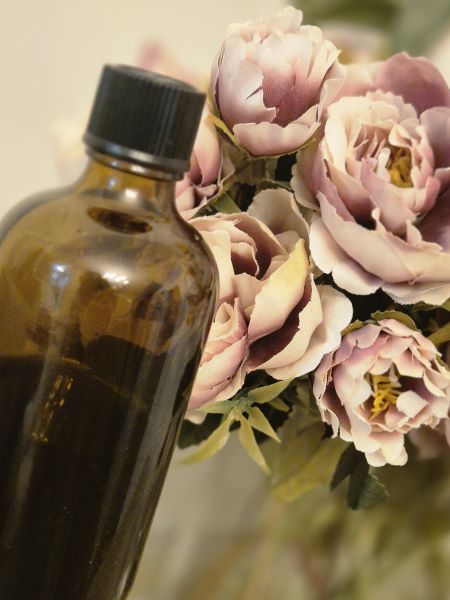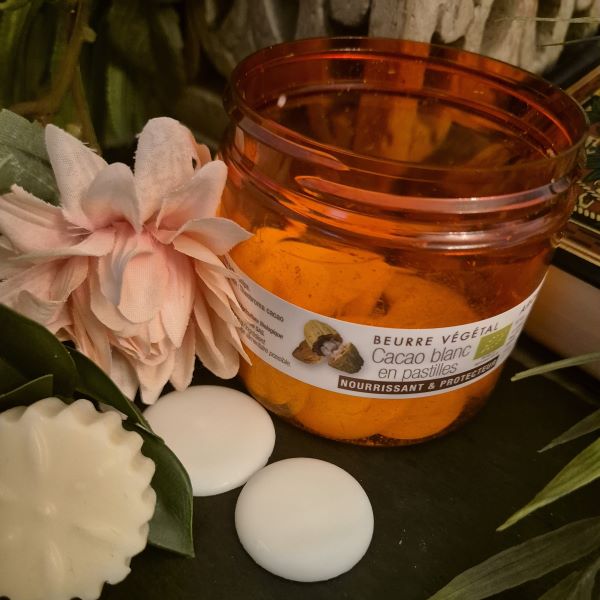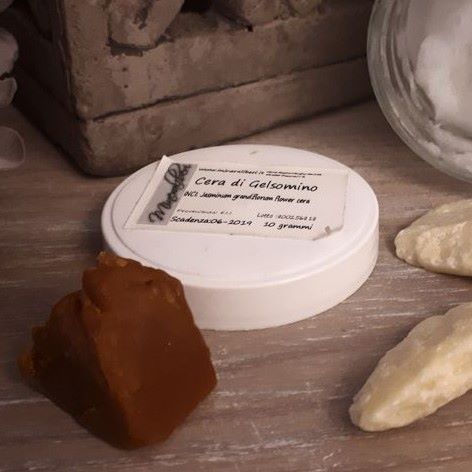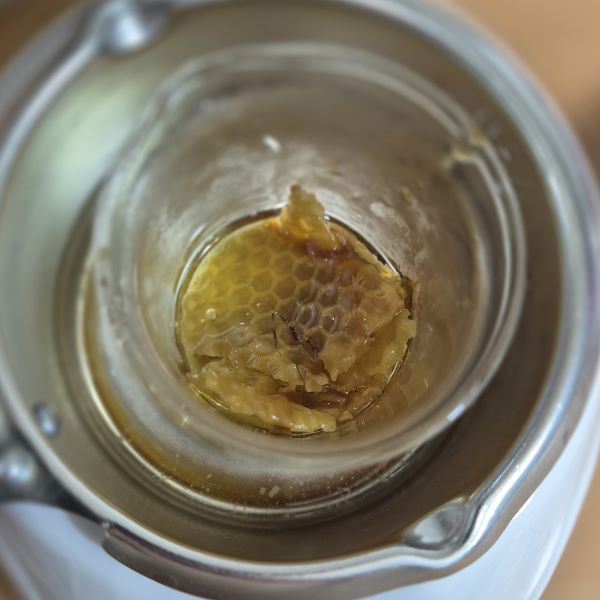Creating your own cosmetics is a wonderful adventure, but what if we could scent them using only nature’s own notes? No added fragrances. No essential oils. Just the pure, soft whispers of the ingredients themselves.
It might seem a little unconventional at first, but once you try these methods, you’ll find yourself drawn to them, wanting to use them more and more in your DIY creations. For some, not using essential oils or fragrances is not just a preference but a necessity, to avoid allergies or because they’re journeying through special life moments like pregnancy. I’ve been there, and what first felt like a limitation turned into one of the most joyful, enriching chapters of my formulation story. I learned so much from it!
The scents that bloom this way are subtle, authentic, natural, intimate and spark joy.
Continue reading if you feel called to this inspiring path, where you learn to select and blend your ingredients with care, obtaining a scent shaped gently by nature itself. Even if you continue to use essential oils or fragrances, this guide will teach you how to refine the overall scent of your cosmetics, softening or masking overpowering notes that might otherwise interfere with the harmony of your creation.
Cocoa Kisses: Chocolate in Your Potions
Chocolate isn’t just for dessert: it’s a full sensory experience!
- Dark chocolate adds a gourmet twist to lip balms and body butters. Just don’t overdo it (6% is perfect) or it may tint the skin.
- White chocolate, aka cocoa butter, is perfect for this purpose, as explained in the Butters and Oils chapter (see below).
- Cocoa powder shines in dry shampoos, bath bombs, masks and solid cleansers. However, it could tint your skin, so better to use it in small quantities or in rinse-off products.
I used it in these recipes:
- Bicolor solid lotion
- Chocolate and caramel DIY lip balm stick
- Hot chocolate body lottion
- White chocolate lotion bar
- Homemade Dry Shampoo
The Magic of Floral Waters
Hydrosols are gentle, fragrant waters born during the extraction of essential oils. I adore rose, but there’s a whole garden to explore: lavender, neroli, geranium, mint, yuzu, jasmine…
Some hydrosols have a very characteristic scent that might not always be well-loved (like witch hazel), so if your main goal is to enjoy their fragrance, make sure to choose one you genuinely like.
I personally get excited when a DIY cosmetics supplier offers multiple hydrosol varieties. For example, with rose hydrosol, there are several types like Damascena, May Rose, or Alba. I still have a few to try and Rosa Alba is next on my list! I recently tested Centifolia rose water, but found it a bit too vibrant for my taste. My favorite remains Damascena rose: it’s softer, more powdery, and feels just right.
Hydrosols are perfect when you want a light, natural scent without using essential oils:
- Replace water with them in gels and emulsions.
- Their fragrance blooms beautifully in water-based formulas and is more subtle in creams.
- Lovely in body and hair mists for a soft, refreshing touch.
Just a note: heat can reduce their properties, so treat them with care.
Also, choose hydrosols that are preservative-free or contain gentle preservatives that don’t alter the scent, like sodium benzoate and potassium sorbate. Stronger preservatives may interfere with the fragrance, making them less ideal for scent-based formulations.
Creamy Dreams: Scenting with Butters and Oils
There’s a special kind of joy in using raw, natural butters and oils that smell as heavenly as they feel. When they’re unrefined, eco-friendly, and pure, they carry soft whispers of scent, like nature sharing a secret.
Let them guide your formulations with both fragrance and function:
- Cocoa butter – a creamy whisper of white chocolate, warm and cozy.
- Coconut oil – sweet and creamy, directly from a paradise beach.
- Monoi oil – deeply floral, rich, and sensual. It’s a macerated oil.
- Pequi oil – fruity, exotic and playful, with mango-like notes.
- Passion fruit oil – zesty, sweet and vibrant.
- Batana oil – grounding, earthy, and rich like Nutella and Coffee.
- Plum kernel oil – soft, almondy and delicately fruity. Very delicate aroma, best if used at least at 90%.
These oils are perfect in oil based cosmetics like solid lotion bars, body butters, lip balms and oil-based serums, where their natural aroma can truly shine. In emulsions, their fragrance softens, but monoi oil remains beautifully noticeable, even in creams. 
And let’s not forget the gentle power of common macerated oils, like lavender, sage or vanilla, which bring subtle but enchanting notes to creams, balms, and serums.
DIY Beauty Formulator’s Tip: These oils shine best when used generously, ideally 30% or more, to let their scent unfold. Pair these fragrant oils with ingredients with a neutral smell, like white beeswax, coco-caprylate, or fractionated coconut oil to let their aromas take center stage. Always choose cold-pressed, virgin oils to preserve their precious aromatic profiles. Deodorized versions may be convenient but often strip away the very scent you’re seeking.
For even more inspiration and detailed tips on naturally scented oils, wander over to this fragrant blog post: 7 Naturally Scented Oils for Sensory-Rich DIY Cosmetics
I also suggest you my fragrant Pequi oil lotion bar recipe and batana oil lip balm.
Note: While most of these oils are safe during pregnancy, always check individual tolerances and when in doubt, consult your healthcare provider, especially with exotic or floral oils like Monoi, Batana, Passion Fruit or Pequi. Sage and lavender are not recommended during pregnancy.
Poetic Floral Waxes
Soft, rich, and naturally fragrant: floral waxes are a true poetical option. They’re gentler than absolutes or essential oils but still bring depth:
- Use at 1%+ to truly smell their notes.
- Best scents: jasmine, rose and tuberose.
- Orange blossom wax varies and mimosa isn’t for everyone.
Rose wax is a personal favorite: it’s divine in lip balms and adds both scent and taste in one go. Use these wonders in creams, lip products, salves and body butters.
Discover the poetical floral waxes scent with these recipes:

Bee-Loved: The Warm Hug of Honey and Beeswax
Let’s talk beeswax, because not all are created equal! Always go for raw, organic wax from trusted beekeepers, and don’t forget to take a deep sniff before buying. A good beeswax has that irresistible honeyed scent that truly sings in your formulations.
That said, if you’d rather avoid the honey aroma to let other ingredients shine, opt for white beeswax, which has a neutral scent (and color, but I’ll save that topic for another guide, as natural colors deserve their own special spotlight).
Also, keep in mind that some beeswax varieties can also carry a smoky scent, depending on how they’re processed, so it’s always best to try before buying, or read reviews carefully to ensure the aroma suits your formulation goals.
Now, about honey: its scent tends to fade unless used in generous amounts, like in fresh masks or scrubs. If the honey you have is subtle, you likely won’t notice it at all in your finished product. The best option is raw honey, especially if you can get it directly from a local beekeeper, where you can smell and even taste it before purchasing. Raw honey usually carries a deeper, more persistent aroma that adds a warm, golden note to your creations.
I love using both honey and beeswax in a cold cream–based lip balm that truly smells like real, luscious honey.
Extra tip: Pair honey or beeswax with neroli hydrosol: it’s an absolute wonder!

Powdered Blooms: Fragrant Plant Powders
Floral and plant powders like rose, orange and iris are pure poetry for bath products. Perfect for bath bombs, solid cleansers, solid shampoos, bath salts, body powders and dry shampoos.
But avoid using them in cosmetics containing water. They can spoil your beautiful blend, just like infusions, as they are more prone to microbial contamination.
The Scent Spotlight: Letting Natural Aromas Take Center Stage
When your goal is to let just a few naturally fragrant ingredients take the spotlight, intentionality is everything. Think of it as composing a quiet, delicate perfume, where every note matters.
Start by carefully selecting the key aromatic ingredients you want to feature. These could be a beautifully fragrant oil like pequi or monoi, a soft floral wax, or a hydrosol with a heart-stirring aroma.
Smell them together, even before formulating, to get a sense of how they blend. Close your eyes, breathe them in, and ask yourself: do they create harmony? Do they whisper the same story?
Once you’ve chosen your stars, the next step is just as important: selecting supporting ingredients that won’t steal the stage. Go for neutral-smelling bases, like jojoba oil, rice bran oil, fractionated coconut oil or coco-caprylate. These quietly do their job without disrupting the scent profile.
Always smell every ingredient before using it, even the “neutral” ones. Sometimes, an oil or butter might carry a subtle scent you didn’t expect, especially if it’s unrefined or slightly oxidized. Think of this as curating a fragrant cast: every element, even the background players, should support your leading notes.
When you work this way, with intention, care and curiosity, your cosmetic becomes more than skincare. It becomes a sensory ritual, where scent gently guides the experience and lingers like a soft echo on the skin!
When Scents Clash: Ingredients with Strong Smells
Sometimes, a single ingredient can overpower your entire formulation. And when you're working with delicate, naturally scented creations, balance is everything.
Be mindful of these pungent players:
- Some oils and butters carry very distinct, sometimes unpleasant scents.
Examples include evening primrose oil, linseed, neem, nigella (black cumin), mustard, olive, marula, borage, wheat germ oil and cupuacu or kombo butters. Unrefined shea butter, in particular, can smell unexpectedly like cheese.
In general, unrefined or virgin oils tend to retain their full aromatic character, for better or worse. (This is a good thing when the scent is beautiful, like with pequi oil, but not so welcome with oils that don't share that fragrant charm.)
If you're skipping added fragrances and want the soft aroma of your chosen ingredients to shine, consider using deodorized versions of strong-smelling oils. Keep in mind, though, that deodorized versions might have slightly fewer benefits.
As an alternative, choose oils that are naturally light or neutral in scent, like jojoba, rice bran, grapeseed, fractionated coconut oil, or coco-caprylate. These allow your fragrant stars to shine without interference.
- Some preservatives, like Cosgard, have a relevant smell that can dominate your blend. While they're essential for preventing contamination, be mindful of their scent. To soften their presence, surround them with ingredients that have naturally pleasant aromas, like cocoa butter, or opt for milder-smelling alternatives when suitable.
- Though beneficial, hydrolyzed proteins often carry a strong scent. If you're creating a formula meant to smell lovely and delicate, they’re best left out or replaced with more neutral actives.
Gentle Neutralizers
To soften, mask, or harmonize strong scents, especially ones like Cosgard, you can use:
- Farnesol – a subtle floral note that blends beautifully and neutralizes off smells. Could be allergenic for some.
- Benzoin Oleoresin – brings a balsamic, vanilla-like softness that balances sharper notes. However, is like using an essential oil.
- Cocoa butter: a 4-5%+ cocoa butter in your cream can gently soften the sharper scent of Cosgard with its sweet touch.
Additional Tips to Enchant Your Naturally Scented Creations
Small Batch First
Always make a small test batch when using a new ingredient with scent. Even beautiful natural aromas can shift when blended or emulsified, so it’s best to explore on a miniature canvas first.
Do a Test
If you're unsure how strong the scent might be in your final blend, try this test.
If you are testing a oil, dilute 1 ml of the oil in 9 ml of a neutral carrier like fractionated coconut oil. This gives you a sense of its impact at 10%. Then keep lowering the dose until the scent is no longer noticeable.
The “Rest Day” Rule
Let your formulation rest overnight before making scent adjustments. Some natural aromas soften or evolve after a few hours, revealing their true harmony only with time.
Scent Journaling
Keep a little notebook of your olfactory experiments. Note how certain ingredients behave together, what percentages work best and which combinations made your heart flutter.
Double Duty Scents
Use naturally fragrant ingredients that also bring skincare benefits. Think of them not only as scent-givers, but as active parts of your formulation that nourish, soothe and hydrate.
Don’t Fight Strong Smells: Avoid or Neutralize
If an ingredient has a strong scent that doesn’t align with your vision, either neutralize it wisely or avoid it entirely. Sometimes it’s better to let go of a powerful but clashing note than to struggle covering it up.

